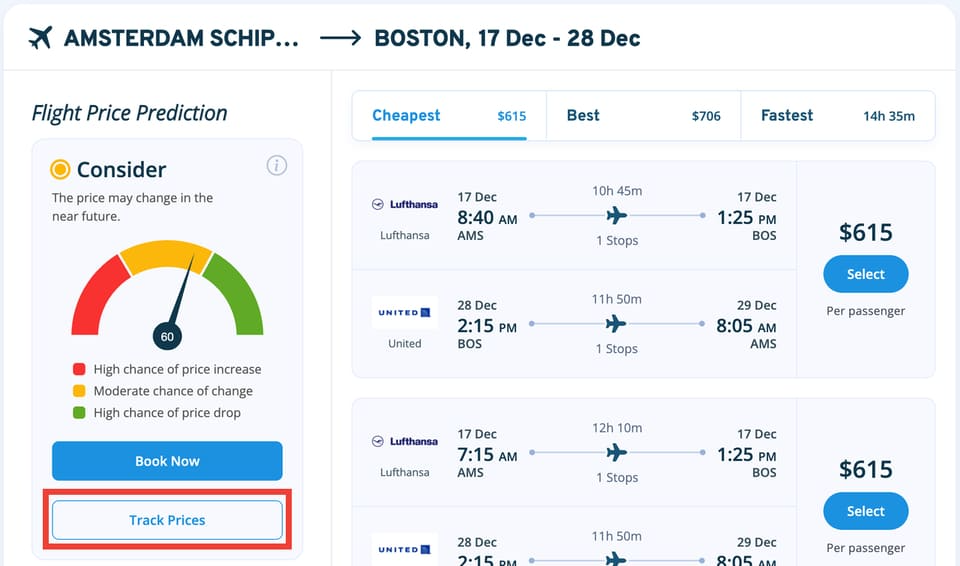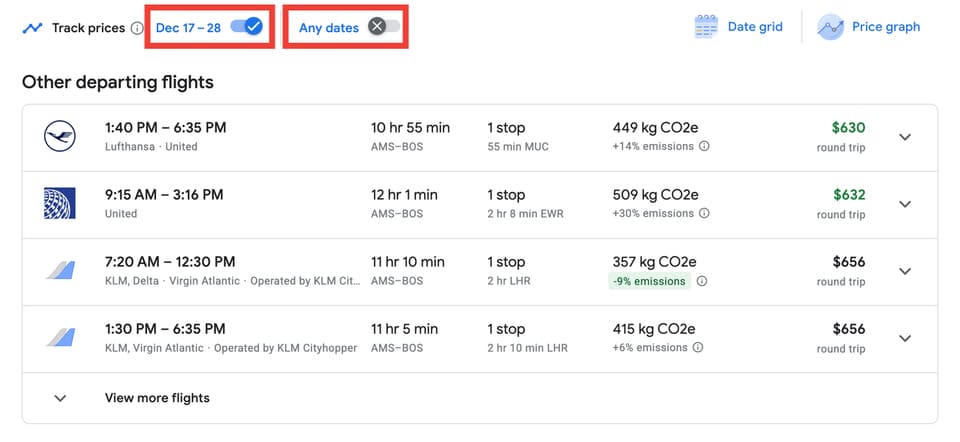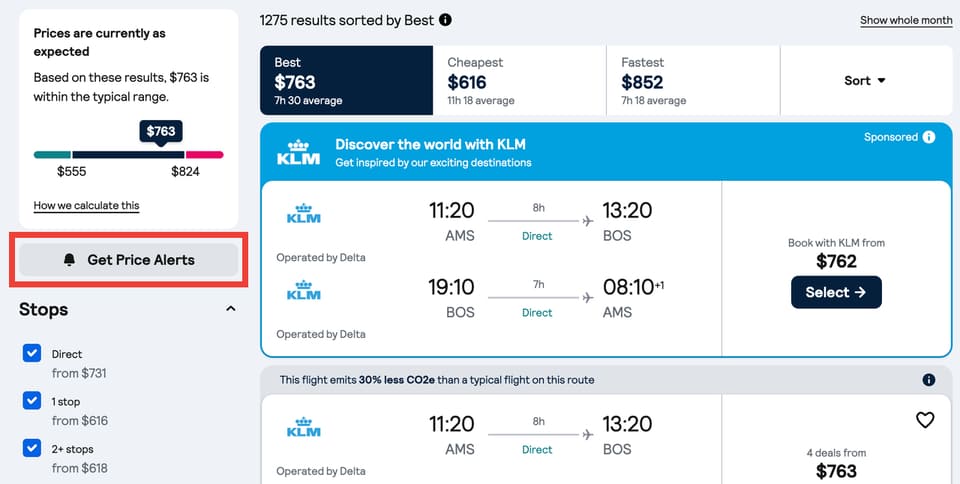
Andrii Yalanskyi/Adobe Stock
Travel demand is up, and true deals are rarer — they appear less often and disappear faster. That makes it harder to catch a price drop at the right moment. You don’t have to overpay, though: classic price tracking with alerts still works. In this guide, you’ll learn how to set alerts, read where prices are heading, react fast to drops, and book at the lowest fare.
How do flight price alerts work?
Airlines manage seat prices in tiers. As seats sell, cheaper tiers close and the price you see can jump. On top of that, different booking sites may refresh data at different times, and airlines use dynamic pricing to adjust fares when demand moves or rivals change theirs. That’s why prices swing within hours. Price alerts keep watching for you and email you when the fare drops, so you can book at the dip instead of refreshing all day.
Set up flight price alerts in minutes (step-by-step)
Setting up tracking is simple: enter your route and dates, then turn on notifications. That’s it. No daily refreshing, no spreadsheets. You’ll get a ping when the price moves. Below are the quickest ways to set it up in the tools people actually use.
AirTrackBot
-
Enter From / To / Dates.
-
Tap Track Prices, enter your email, and confirm. Done.

What the alert looks like: a short email with the route, the new low compared to the last seen price, the percent change up or down, and a one-tap Book link. Clean, no fluff.
Tip: If you use Telegram, you can set up alerts via the AirTrackBot bot and receive instant notifications right in your chat.
Google Flights
-
Search your route and dates. On the results page, toggle “Track prices.” On desktop it’s in the top-left above the results. On mobile, use the same “Track prices” toggle
-
Optional: turn on Any dates to watch a flexible window.

What the alert looks like: an email with the route, the new lowest fare, a small price graph, and a link back to your search.
Skyscanner
-
Search your route and dates, then tap the bell / Get Price Alerts and sign in if asked.
-
Confirm your email notifications in the prompt. If you are already signed in, the alert is created in one click. Very convenient.

What the alert looks like: an email or app notification with the route, the current lowest fare, and a View deal button that takes you back to the results.
When to buy flights: use alerts & predictions
There isn’t a magic day to buy. Google’s analysis shows the “book on a specific weekday” trick rarely changes the price. Instead, watch your route and act when you see a clear drop. Midweek departures often cost less than weekends, so the day you fly matters more than the day you purchase.
Use an airfare prediction tool to see whether fares are likely to rise or fall in the near term. Like a weather forecast, it is never 100% accurate, but it shows the trend so you can judge momentum instead of guessing.
Check the confidence or range the tool provides, combine it with your own price notifications, and act when the prediction and a real drop line up. This simple combo helps you buy on the dip rather than chasing it after the fare rebounds.
After booking: should you keep tracking?
After you book, leave notifications on for the same route and dates. If you see a cheaper fare, check the rules of your ticket and the policy of the place you bought from, since changes usually go through the original seller. If a free cancel or change option applies, rebook at the lower price. If you used an OTA, compare the airline’s direct price as well. Move quickly, and always compare like for like, same cabin and baggage.
What flight price alerts can’t do
-
They do not guarantee a specific fare. Alerts only flag an opportunity.
-
They cannot hold seats. Inventory may sell out before you click through.
-
They may not catch ultra-short “error fares” in time. These can vanish quickly or be canceled by the airline.
- They may lag on some OTA prices if a site caches data. Always recheck at checkout before you pay.
Conclusion
Catching a real deal is not about luck. Set notifications on the routes you care about, pick a sensible threshold, and watch a small date window rather than a single day. Act when you see a clear drop. Keep one alert running after you book so you do not miss a new low. Remember what alerts cannot do: they do not hold seats and they do not change fare rules, so always verify bags and cabin before you pay.
If you want the fastest path to savings, use AirTrackBot. Setup takes seconds, emails are clean, Telegram works for instant pings, and you can track as many routes as you need.
FAQs About Tracking Flight Prices
What’s the best app to track flight prices?
It depends on your workflow. Google Flights is great for simple tracking and quick trend checks. AirTrackBot is best when you want fast setup, clean notifications, and route-first tracking (email or Telegram). Skyscanner is handy if you like a meta-search view with alerts. (Choose the tool that fits how you search.)
Do prices go down closer to the date?
Not reliably. Focus on watching your route and buying on a clear drop rather than waiting for a “magic day”.
Does incognito help?
There’s no solid evidence that private mode alone makes flights cheaper. Price swings mostly come from inventory and demand, not your browser mode.
Can I track multiple routes at once?
Yes. Google Flights lets you create multiple alerts. Skyscanner supports multiple routes if you are signed in. AirTrackBot allows unlimited notifications and lets you keep a watchlist of as many routes as you need.
Does Google Flights notify price drops?
Yes. Turn on Track prices on a route or a specific flight and you’ll get email notifications when the price changes. You can also track Any dates if your timing is flexible.
Is Sunday the best day to book?
Some industry reports still find a small “book on Sunday” edge in specific markets/years. It’s modest; tracking your route matters more than chasing a weekday.
Do airlines change prices multiple times a day?
They price in fare “buckets,” so changes look jumpy rather than continuous. Research shows discrete tiers drive bigger jumps and occasional stickiness, not tiny constant tweaks.
Are midweek departures really cheaper than weekends?
On average, yes. Recent Google analysis: Monday–Wednesday flights are about 13% cheaper than weekend departures.
Are flights cheaper on Tuesdays?
Not really. Google’s data shows Tuesday bookings are only ~1.3% cheaper than the priciest day; savings come more from when you fly than when you buy. Monday–Wednesday departures average ~13% cheaper than weekends.
How far in advance should I book to get the lowest fare?
Windows vary by route, but large datasets suggest booking domestic 1–3 months out and international ~18–29 days out can beat last-minute prices. Treat these as guides, not rules—still track your route.
Useful Links:
Flight Price Predictor
Book at the right time and save with AI-powered price predictions.
Check Price Prediction